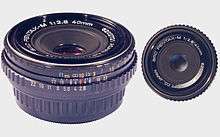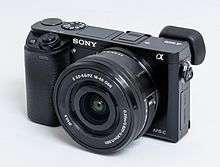Pancake lens
A pancake lens is colloquial term for a flat, thin lens (short barrel), generally a normal or slightly wide prime lens for a camera.

Motivation
Pancake lenses are primarily valued for providing quality optics in a compact package. The resulting camera and lens assembly may even be small enough to be pocketable, a design feature which is usually impractical with conventional SLR bodies and lens assemblies. Pancake lenses can be very short and flat because they do not need large amounts of optical correction, i.e. extra lens elements.
The problem arises when such lenses have too short a focal length to fit in front of the retractable mirrors used in reflex cameras. In such a situation, a pancake lens focuses in front of, rather than on, the focal plane (film or light sensor) of the camera. This has necessitated the design of retrofocus lenses that refocus the image further back, which is why such lenses are longer and bulkier than their "pancake" equivalents.
Pancake-style prime lenses are generally simpler to manufacture than pancake zoom lenses like Sony E PZ 16-50mm F3.5-5.6 due to the general lack of an internal micromotor and fewer image correcting elements, allowing for a thinner profile. Because of this limitation, pancake zoom lenses are much less common.
While there is no specific size and weight in defining a pancake lens, most are light-weight and no more than a few centimeters in length. This varies greatly depending upon the lens' build quality, focal length, and maximum aperture.
Body-Cap Lenses
A body-cap lens is an extreme type of pancake lens that is designed to both protect the camera internals as a body cap normally would, yet still allow the user to take photos. These lenses generally have no more than a couple optical lens elements, no image correcting elements, a very-slow fixed aperture, an extremely thin focusing ring (if any), and a retractable lens element cover. Due to this compromise in design, body-cap lenses generally suffer from numerous image quality issues such as heavy vignetting and poor image sharpness.
Examples of body-cap lenses include the Olympus Body Cap Lens 15mm f/8 and the Fujifilm XM-FL 24mm f/8.

History
In the 1960s and 1970s the Nikon GN lens was a notable example, while in the 1970s and 1980s pancake lenses were used in compact single lens reflex (SLR) cameras.[1]
Throughout the 2010s, the design has seen a resurgence due to the growth of the mirrorless interchangeable-lens digital camera market. Pancake lenses have increasingly become lighter and feature thinner profiles than years past. An extreme example of this trend would be the Pentax DA 40mm F2.8 XS, released in 2012 and measuring only 9.14 millimetres (0.360 in) long.
List of Pancake Lenses
| Name | Type | Format | Max Length |
|---|---|---|---|
| Canon EF-S 24mm F2.8 STM | Prime | APS-C | 22.9 millimetres (0.90 in) |
| Canon EF-M 22mm F2.0 STM | Prime | APS-C | 23.7 millimetres (0.93 in) |
| Canon EF 40mm F2.8 STM | Prime | 35mm Full Frame | 22.8 millimetres (0.90 in) |
| Fujinon XF 27mm F2.8 | Prime | APS-C | 23.0 millimetres (0.91 in) |
| Fujifilm XM-FL 24mm f/8[2][3][4] | Prime | APS-C (X-mount) | 21.0 millimetres (0.83 in) |
| Konica Hexanon AR 40mm f/1.8 | Prime | 35mm Full Frame | 27.0 millimetres (1.06 in) |
| Neewer E 28mm f/2.8 | Prime | APS-C | 29.0 millimetres (1.14 in) |
| Nikon 1 NIKKOR 10mm F2.8 | Prime | CX | 22.0 millimetres (0.87 in) |
| Nikon 1 NIKKOR 10-30mm F3.5-5.6 PD | Zoom | CX | 28.0 millimetres (1.10 in) |
| Nikon 1 NIKKOR 18.5mm F1.8 | Prime | CX | 36.0 millimetres (1.42 in) |
| Nikon 50mm F1.8 E AIS | Prime | 35mm Full Frame | 28.0 millimetres (1.10 in) |
| Nikon 45mm F2.8 AI P | Prime | 35mm Full Frame | 17.0 millimetres (0.7 in) |
| Nikon Auto GN Nikkor 45mm F2.8 | Prime | 35mm Full Frame | 20 millimetres (0.79 in) |
| Olympus Zuiko Auto-S 1:2 f = 40 mm | Prime | 35mm Full Frame | 25 millimetres (0.98 in) |
| Olympus E. Zuiko Auto-S 1:2,8 f = 38 mm | Prime | 35mm Half Frame | 14 millimetres (0.55 in) |
| Olympus 14-42mm F3.5-5.6 EZ | Zoom | Micro Four Thirds | 22.9 millimetres (0.90 in) |
| Olympus 17mm F2.8 | Prime | Micro Four Thirds | 22.0 millimetres (0.87 in) |
| Olympus 25mm f/2.8 ED | Prime | Four Thirds | 23.5 millimetres (0.93 in) |
| Panasonic Lumix G Vario 12-32mm F3.5-5.6 | Zoom | Micro Four Thirds | 24.0 millimetres (0.94 in) |
| Panasonic Lumix G X Vario PZ 14-42mm F3.5-5.6 | Zoom | Micro Four Thirds | 26.8 millimetres (1.06 in) |
| Panasonic Lumix G 14mm F2.5 | Prime | Micro Four Thirds | 20.5 millimetres (0.81 in) |
| Panasonic Lumix G 20mm F1.7 II ASPH | Prime | Micro Four Thirds | 26.0 millimetres (1.02 in) |
| Pentax DA 21mm F3.2 | Prime | APS-C | 25.0 millimetres (0.98 in) |
| Pentax DA 40mm F2.8 | Prime | APS-C | 15.0 millimetres (0.59 in) |
| Pentax DA 40mm F2.8 XS | Prime | APS-C | 09.14 millimetres (0.360 in) |
| Pentax FA 43mm F1.9 | Prime | 35mm Full Frame | 27.0 millimetres (1.1 in) |
| Pentax DA 70mm F2.4 | Prime | APS-C | 25.4 millimetres (1.00 in) |
| Samsung NX 16mm F2.4 | Prime | APS-C/DX | 24.0 millimetres (0.94 in) |
| Samsung NX 20mm F2.8 | Prime | APS-C/DX | 25.0 millimetres (0.98 in) |
| Samsung NX 30mm F2 | Prime | APS-C/DX | 22.0 millimetres (0.87 in) |
| Samyang Optics / Rokinon AF 35 mm f/2.8 FE | Prime | 35mm Full Frame | 33.0 millimetres (1.30 in) |
| Sony E PZ 16-50mm F3.5-5.6 OSS | Zoom | APS-C | 29.9 millimetres (1.18 in) |
| Sony E 16mm F2.8 | Prime | APS-C | 22.6 millimetres (0.89 in) |
| Sony E 20mm F2.8 | Prime | APS-C | 20.4 millimetres (0.80 in) |
| Sony FE 35mm f2.8 ZA | Prime | 35mm Full Frame | 37.0 millimetres (1.46 in) |
| Voigtlander 20mm F3.5 Color Skopar SL II | Prime | 35mm Full Frame | 28.6 millimetres (1.13 in) |
| Voigtlander 40mm F2.0 Ultron SL II | Prime | 35mm Full Frame | 24.5 millimetres (0.96 in) |
 Olympus Pen F/FT (35mm analog film) lens E. Zuiko Auto-S 1:2,8 f = 38 mm 1966
Olympus Pen F/FT (35mm analog film) lens E. Zuiko Auto-S 1:2,8 f = 38 mm 1966.jpg) Canon EF 40mm f/2.8 STM pancake lens
Canon EF 40mm f/2.8 STM pancake lens

 Sony E PZ 16-50mm F3.5-5.6 OSS pancake zoom lens
Sony E PZ 16-50mm F3.5-5.6 OSS pancake zoom lens
References
- DPReview forum: Re: Why is a pancake lens a big deal?, Photomonkey, 10:01:14 PM, Thursday, September 14, 2006
- https://fujifilm.jp/personal/digitalcamera/accessories/lens/filterlens/
- http://fujibuzz.com/fujifilm-announces-xm-fl-x-mount-lens-four-filter-types-built/
- https://petapixel.com/2015/02/06/fujis-new-xm-fl-x-mount-body-cap-lens-built-photo-filters/